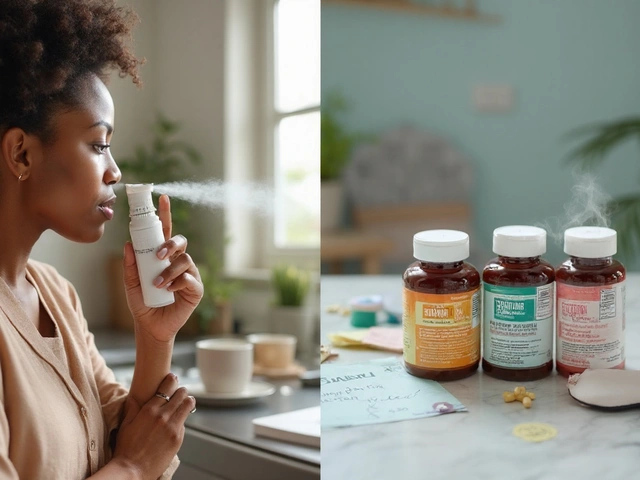
Introduction to Benzalkonium Chloride and Zinc Oxide
As a blogger who is always on the lookout for new and effective ways to treat inflammation, I recently stumbled upon a combination of two ingredients that have been proven to reduce inflammation effectively. In this article, we will explore Benzalkonium chloride and Zinc oxide, their individual properties, and how they work together to alleviate inflammation.
Understanding Benzalkonium Chloride
Benzalkonium chloride, also known as BKC, is a cationic surfactant and a quaternary ammonium compound. It has been widely used as a disinfectant and antiseptic in various applications, such as in personal care products, pharmaceuticals, and even in the food industry. Its antimicrobial properties make it an effective ingredient in reducing the growth of bacteria and fungi, which can contribute to inflammation.
Zinc Oxide: A Powerful Anti-Inflammatory Agent
Zinc oxide is an inorganic compound that has been used for centuries for its various therapeutic properties. It is a versatile ingredient that can be found in a range of products, including sunscreens, ointments, and even in some food items. Zinc oxide has been known for its anti-inflammatory and wound-healing properties, making it an effective treatment for various skin conditions such as acne, eczema, and burns.
Combining Benzalkonium Chloride and Zinc Oxide
When combined, Benzalkonium chloride and Zinc oxide form a powerful duo that can effectively reduce inflammation. The antimicrobial properties of Benzalkonium chloride help to minimize the growth of bacteria and fungi, while the anti-inflammatory properties of Zinc oxide work to soothe and heal the affected area. This synergistic effect makes the combination of these two ingredients a potent solution for treating various inflammatory conditions.
Benefits of Benzalkonium Chloride and Zinc Oxide for Inflammation
Using the combination of Benzalkonium chloride and Zinc oxide to treat inflammation comes with a multitude of benefits. Some of these include:
- Reduced redness and swelling
- Decreased pain and discomfort
- Faster healing of wounds and skin irritations
- Prevention of infection
- Improved overall skin health
How to Use Benzalkonium Chloride and Zinc Oxide for Inflammation
There are various ways to incorporate Benzalkonium chloride and Zinc oxide into your inflammation-fighting routine. These can include using creams, ointments, or even sprays that contain both of these ingredients. It is essential to follow the product's instructions and consult a healthcare professional if you have any concerns or questions about using these products.
Safety and Precautions
While Benzalkonium chloride and Zinc oxide are generally considered safe for use, it is essential to be aware of any potential side effects or precautions. Some individuals may experience skin irritation or an allergic reaction to either of these ingredients. If this occurs, discontinue use and consult a healthcare professional. Additionally, it is crucial to avoid contact with the eyes and mucous membranes, as this can cause irritation and discomfort.
Success Stories and Testimonials
Many people have experienced the benefits of using Benzalkonium chloride and Zinc oxide to treat inflammation. From those suffering from chronic skin conditions to individuals looking for relief from minor cuts and scrapes, the combination of these ingredients has proven to be an effective solution. By reading testimonials and success stories, you can gain insight into how these ingredients have helped others and what results you might expect from using them in your own inflammation-fighting routine.
Where to Find Products Containing Benzalkonium Chloride and Zinc Oxide
Finding products that contain Benzalkonium chloride and Zinc oxide can be as easy as visiting your local pharmacy or searching online. Many over-the-counter creams, ointments, and sprays contain these ingredients, making it simple to incorporate them into your daily routine. Be sure to read product labels and choose a product that suits your specific needs and preferences.
Conclusion: The Power of Benzalkonium Chloride and Zinc Oxide
In conclusion, the combination of Benzalkonium chloride and Zinc oxide offers a powerful and effective solution for reducing inflammation. By understanding the properties of these ingredients and how they work together, you can make informed decisions about incorporating them into your inflammation-fighting routine. Remember to follow the product's instructions, consult a healthcare professional if needed, and be aware of any potential side effects or precautions. With the right approach, you can experience the benefits of Benzalkonium chloride and Zinc oxide for yourself and enjoy improved skin health and reduced inflammation.





Arjun Santhosh
May 6, 2023 AT 15:50Bzlkonium + zinc iz da best for red skin lol
Stephanie Jones
May 6, 2023 AT 16:56One could argue that the very act of chasing a chemical elixir for inflammation mirrors our endless quest for meaning in a chaotic world. The blend of benzalkonium chloride and zinc oxide, while promising, also whispers of humanity's dependence on synthetic solace. It is a subtle reminder that relief often comes wrapped in a paradox of control and surrender. Yet, perhaps the true cure lies not in the ointment but in the acceptance of impermanence. In that sense, the article serves as a quiet meditation on modern medical rituals.
Nathan Hamer
May 6, 2023 AT 18:20Wow, this combo of benzalkonium chloride and zinc oxide is like the dynamic duo of the skincare world! 😮 The antimicrobial punch of BKC cuts through bacterial chaos like a laser, while zinc oxide swoops in like a gentle guardian, soothing the fiery reds. Imagine a battlefield where one side deploys microscopic soldiers, and the other paints the sky with calming hues-this is literally happening on our skin! The synergy isn't just chemistry; it's a narrative of triumph over irritation, a saga where each molecule plays a heroic role. 🤩 Moreover, the anti‑inflammatory chorus of zinc oxide sings a lullaby to swollen tissues, coaxing them back to peace. It's almost poetic, the way the two agents converse, whispering "we've got this" to every irritated pore. Of course, one must heed the dosage, for even heroes have limits, and over‑use could tip the balance toward dryness. The article captures this dance well, yet it leaves room for DIY enthusiasts to experiment responsibly. As we explore further, imagine future formulations that harness nanotechnology to deliver these agents precisely where needed-like guided missiles for inflammation! 🌟 And think about the broader implications: could this partnership inspire new treatments for ocular inflammation, given both compounds' ocular safety profiles? The possibilities seem endless, like a river that never stops flowing. In short, the blend is a testament to how smart chemistry can turn everyday irritation into a manageable nuisance, letting us focus on living rather than constantly battling our own skin.
Tom Smith
May 6, 2023 AT 18:28Ah, the grand epic of BKC and zinc oxide-a tale as ancient as the internet comments section. While your enthusiasm is charming, let’s not forget that synergy on paper doesn’t always translate to miracle cream in a bathroom cabinet. Over‑application, for instance, could invite the very irritation you hope to avoid-ironic, isn’t it? In short, moderation is the real hero here, not just the flashier ingredients.
Kyah Chan
May 6, 2023 AT 21:06From a clinical perspective, the safety profile of benzalkonium chloride warrants a cautious appraisal, particularly concerning ocular exposure. Empirical studies have delineated dose‑dependent cytotoxicity, underscoring the necessity of stringent formulation controls. Zinc oxide, while generally well‑tolerated, may precipitate contact dermatitis in sensitized individuals. Therefore, rigorous risk‑benefit analysis remains indispensable prior to widespread recommendation.
Ira Andani Agustianingrum
May 6, 2023 AT 23:53Hey there! If you’re thinking about trying this combo, start with a tiny patch test-just a dab on the inner forearm-and wait 24 hours. If it feels fine, you can gradually increase the area you cover. Remember to keep the skin clean before applying, and don’t forget to moisturize afterward. Consistency is key, but listen to your body!
James Higdon
May 7, 2023 AT 00:01While the pragmatic advice is appreciated, it is imperative to underscore the moral responsibility of endorsing any pharmacological agent without exhaustive longitudinal data. The allure of immediate relief must not eclipse our duty to safeguard public health. Hence, any recommendation should be accompanied by a disclaimer emphasizing professional consultation.
Wanda Smith
May 7, 2023 AT 02:40One cannot ignore the hidden agenda behind the promotion of such chemical cocktails; the pharmaceutical lobby thrives on our dependency. The seamless integration of benzalkonium chloride into everyday products is no accident-it erodes our natural defenses while pretending to heal. We must stay vigilant and question the narrative presented to us.
Bridget Jonesberg
May 7, 2023 AT 02:48It is, indeed, a fascinating observation that the very mechanisms purported to protect us may simultaneously serve as instruments of subtle control. The discourse surrounding benzalkonium chloride and zinc oxide, when examined through a historical lens, reveals a pattern of technological optimism tempered by recurring concerns over autonomy. While the scientific community offers empirical data, the broader sociopolitical context cannot be dismissed. The interplay of corporate interests, regulatory frameworks, and consumer trust constitutes a complex tapestry, wherein each thread influences perception and adoption. In this light, the article’s optimistic tone warrants a measured consideration of underlying power dynamics.
Marvin Powers
May 7, 2023 AT 05:26Alright, folks, let’s take a moment to appreciate the genius of slapping two old‑school compounds together and calling it a breakthrough. The sarcasm is real-if I wanted a magic potion, I’d ask a wizard, not a pharmacy shelf. Still, kudos to the marketers who can spin ‘synergy’ into a buzzword that makes us feel like we’re part of a cutting‑edge experiment. In practice, though, a little caution goes a long way; a dab here, a swipe there, and you’ll avoid turning your skin into a chemistry lab. Remember, the real power isn’t in the bottle but in understanding how and when to use it-so keep it simple, stay informed, and don’t let the hype dictate your routine.